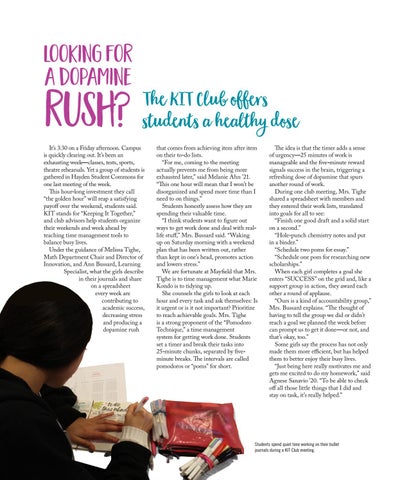Looking for a dopamine
rush?
The KIT Club offers students a healthy dose
It’s 3:30 on a Friday afternoon. Campus is quickly clearing out. It’s been an exhausting week—classes, tests, sports, theatre rehearsals. Yet a group of students is gathered in Hayden Student Commons for one last meeting of the week. This hour-long investment they call “the golden hour” will reap a satisfying payoff over the weekend, students said. KIT stands for “Keeping It Together,” and club advisors help students organize their weekends and week ahead by teaching time management tools to balance busy lives. Under the guidance of Melissa Tighe, Math Department Chair and Director of Innovation, and Ann Bussard, Learning Specialist, what the girls describe in their journals and share on a spreadsheet every week are contributing to academic success, decreasing stress and producing a dopamine rush
that comes from achieving item after item on their to-do lists. “For me, coming to the meeting actually prevents me from being more exhausted later,” said Melanie Ahn ’21. “This one hour will mean that I won’t be disorganized and spend more time than I need to on things.” Students honestly assess how they are spending their valuable time. “I think students want to figure out ways to get work done and deal with reallife stuff,” Mrs. Bussard said. “Waking up on Saturday morning with a weekend plan that has been written out, rather than kept in one’s head, promotes action and lowers stress.” We are fortunate at Mayfield that Mrs. Tighe is to time management what Marie Kondo is to tidying up. She counsels the girls to look at each hour and every task and ask themselves: Is it urgent or is it not important? Prioritize to reach achievable goals. Mrs. Tighe is a strong proponent of the “Pomodoro Technique,” a time management system for getting work done. Students set a timer and break their tasks into 25-minute chunks, separated by fiveminute breaks. The intervals are called pomodoros or “poms” for short.
The idea is that the timer adds a sense of urgency—25 minutes of work is manageable and the five-minute reward signals success in the brain, triggering a refreshing dose of dopamine that spurs another round of work. During one club meeting, Mrs. Tighe shared a spreadsheet with members and they entered their work lists, translated into goals for all to see: “Finish one good draft and a solid start on a second.” “Hole-punch chemistry notes and put in a binder.” “Schedule two poms for essay.” “Schedule one pom for researching new scholarships.” When each girl completes a goal she enters “SUCCESS” on the grid and, like a support group in action, they award each other a round of applause. “Ours is a kind of accountability group,” Mrs. Bussard explains. “The thought of having to tell the group we did or didn’t reach a goal we planned the week before can prompt us to get it done—or not, and that’s okay, too.” Some girls say the process has not only made them more efficient, but has helped them to better enjoy their busy lives. “Just being here really motivates me and gets me excited to do my homework,” said Agnese Sanavio ’20. “To be able to check off all those little things that I did and stay on task, it’s really helped.”
Students spend quiet time working on their bullet journals during a KIT Club meeting. 22
POSTSCRIPTS 2019























